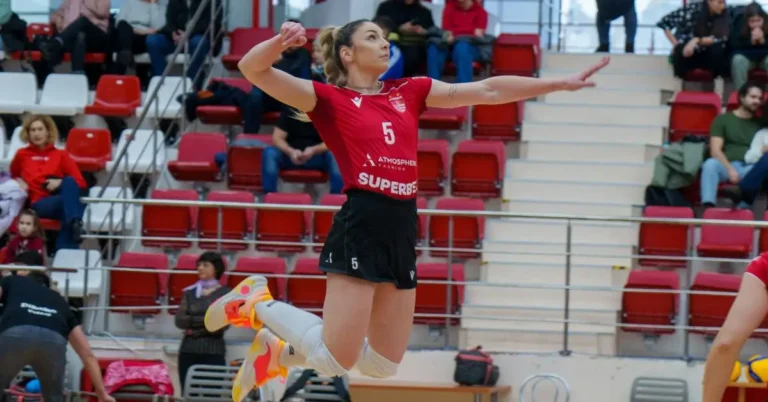If you want to play volleyball on a competitive level and you are already part of a team, Philip and I bet you already heard about the famous butterfly volleyball drill. This drill is one of the most famous and popular exercises. The reason for this is that the butterfly volleyball drill targets the basic fundamentals.
This adaptable drill is allowing to fine-tune serving, passing and setting. Furthermore it helps to build muscle memory and improves communication within the team members. Additionally the butterfly volleyball drill is teaching us to anticipate and react as a unit.
Basics of the Butterfly Volleyball Drill
Before we dive into the specifics, let’s understand why the butterfly volleyball drill is a game-changer in practice sessions—it boosts players’ agility, serving, passing skills, and overall conditioning.
Understanding the Drill Diagram
The drill diagram is crucial for visualizing the dynamic flow of the butterfly drill. Imagine the court as a stage where players synchronize their movements in a structured dance. In essence, the drill involves a server, a passer, and a target. Each takes turns rotating in a manner similar to the fluttering movement of a butterfly’s wings, which is how the drill gets its name.

Setting Up the Court for Practice
To get the court ready for the butterfly volleyball drill, we need to focus on the baseline, as this is where the servers line up. The formation usually requires groups of players on opposite ends of the court:
- Servers start at the baseline.
- Passers position opposite the servers.
- Setters or targets wait near the net to complete the pass-set-hit sequence.
This setup ensures that all players actively engage in the drill, regardless of their position.
Drill Benefits and Goals
Our primary goal with the butterfly volleyball drill is to refine our skills in a high-intensity, realistic environment. It teaches us to maintain momentum, communicate effectively, and develop our serve-receive game. As we rotate through each role on the court, every player gains the opportunity to work on their precision and speed, making the drill an all-encompassing workout.
Conducting the Drill
The butterfly volleyball drill is an excellent way for our team to sharpen skills in movement, communication, and ball control. As we walk through setting up the drill, let’s focus on the roles each player will assume, the flow of the activity, and the specific techniques to enhance our serve receive and passing game.
Roles and Responsibilities
In the butterfly drill, each player has a pivotal role. Our servers initiate the drill by aiming the ball toward the passer’s general area, ensuring the activity’s continuity. After the serve, they join the waiting line of passers, fostering teamwork and keeping the drill fluid. Passers are responsible for accurately sending the ball to the setters. Setters then focus on setting the ball for hitters or recycling it back into the drill, promoting continuous movement and communication between players. Coaches should constantly observe and provide feedback, helping to fine-tune our teamwork and individual skills.
- Server: Serves and joins the passing line.
- Passer: Receives the serve and passes to the setter.
- Setter: Sets the ball for hitters or continues the drill.
- Coaches: Monitor and guide players.
Movement and Ball Control
To excel in the butterfly volleyball drill, we must keep our movement intentional and our ball control precise. Meticulous footwork and positioning are crucial as we transition from serving to passing, and finally to setting. Each step we take and each pass we make should be deliberate, keeping the ball’s trajectory smooth and controlled. Staying light on our feet allows us swift and efficient repositioning, which is vital in actual game scenarios.
Serve Receive and Passing Techniques
Our serve receive and passing are foundational to the success of the butterfly volleyball drill—and, by extension, to our performance in matches. When receiving the serve, passers must use effective techniques to “cushion” the ball, providing an excellent settable pass to the setter. This requires keen focus and anticipation. Our passing should follow through towards the target, emphasizing the importance of accuracy over power. Adopting consistent serve receive and passing techniques within the butterfly drill not only enhances our coordination but also trains us to remain composed under pressure.
Progressions and Variations
Mastering the butterfly volleyball drill is an adventure we embark on together. Starting with the basics, we gradually elevate the challenge, ensuring that each step brings us closer to game-ready skills. Whether you’re new to the court or fine-tuning your team’s seamless coordination, there’s a variation to meet you at your level.
Beginner-Friendly Adjustments
For those just starting out, consider simplifying the drill to build confidence and basic skills. We can:
- Shorten the serving distance to ensure that passes are more successful.
- Allow for catch-and-throw techniques to get the feel for the ball’s trajectory.
These tweaks provide beginners the chance to improve their stamina and agility without the pressure of advanced skills.
Adding Complexity for Advanced Teams
High-level teams thrive on challenge and complexity. To push the boundaries:
- Introduce speed: Mimic a high-paced game with rapid serves and passes.
- Incorporate movement: Add lateral sprints or backpedals into the drill sequence.
Each variation refines your team’s ability to adapt and perform in game-like scenarios, promoting a superior level of flexibility in play.
FAQs
When it comes to improved agility and coordination on the court, the butterfly volleyball drill is a fantastic tool. Let’s dive into some frequently asked questions about this dynamic exercise.
Why is the butterfly drill called the butterfly drill?
The name originates from the drill’s movement pattern, which resembles the wings of a butterfly. Players move in a way that mimics the shape of the action, with servers and passers rotating through positions in a figure-eight formation.
Why is the butterfly drill so popular?
Due to its comprehensive nature, coaches embrace the butterfly drill for its capacity to simultaneously develop serving, passing, and setting skills. Its popularity stems from the drill’s versatility, allowing it to be modified for players of various skill levels and its effectiveness in simulating game-like scenarios.
What drills are similar to the butterfly drill?
Similar drills that foster a wide range of skills include the pepper drill for ball control, the hitting lines drill for attacking and passing, and the serve-receive drill, which focuses on accurately receiving serves. Each drill covers different facets of volleyball but shares the common goal of honing essential skills through repetition and movement.
We hope you could find some valuable input about butterfly volleyball drills. We would be curious about your experience: How do your block drills for volleyball look like? How did you become a good blocker? Let us know in the comments.
If you liked this article you might also like to dive a little bit deeper into our articles about other volleyball drills.






Thanks for sharing. I read many of your blog posts, cool, your blog is very good.